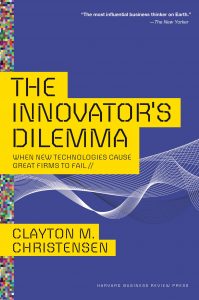
Startups have a great opportunity to overtake industry giants when it comes to disruption. The reason is that it begins in low-margin niche markets as the target customer is often a totally different one than before. Large businesses are slow in offering these because some of the distinguishing factors of a business’s culture and capacity to perform are rigid for them:
1. Resources- Anything you can purchase, sell, hire or fire.
2. Processes- Models of action and communication, both formal and informal.
3. Values- The principles by which managers and employees make all organizational decisions.
Market leaders are packed with resources but have very stiff processes and a fixed set of values, which rarely matches the new target market of a disruptive innovation. These factors are difficult to change, especially short-term.
# Key Takeaways:
– Disruptive innovation: The book introduces the concept of disruptive innovation, which refers to the process by which new technologies or products disrupt existing markets and industries. This can lead to the downfall of established companies who fail to adapt to these changes.
– Sustaining innovation: The author also discusses sustaining innovation, which refers to the continuous improvement and refinement of existing products or technologies. This is important for companies to maintain their competitive edge, but can also blind them to the potential of disruptive innovation.
– The innovator’s dilemma: The main takeaway of the book is the dilemma faced by successful companies when it comes to disruptive innovation. They are often hesitant to invest in new and unproven technologies, as it may not align with their current business model and could potentially cannibalize their existing products.
– The importance of market segmentation: The book emphasizes the importance of understanding different market segments and their needs. Disruptive innovations often target smaller and overlooked segments, which can eventually grow and disrupt the larger market.
– The role of leadership: The author argues that leadership plays a crucial role in navigating the challenges of disruptive innovation. Leaders must be open-minded, willing to take risks, and able to make tough decisions in order to successfully adapt to changing markets.
# Practical Application:
– Embrace disruptive innovation: Companies should not shy away from investing in new and unproven technologies, even if it means disrupting their current business model. This can help them stay ahead of the competition and avoid being disrupted by others.
– Foster a culture of innovation: Organizations should encourage a culture of innovation and experimentation, where employees are given the freedom to explore new ideas and technologies. This can help identify potential disruptive innovations and allow for quick adaptation.
– Understand market segments: Companies should conduct thorough market research to understand different segments and their needs. This can help identify potential opportunities for disruptive innovation and avoid being blindsided by new entrants.
– Develop a flexible business model: In order to adapt to disruptive innovation, companies should have a flexible business model that can accommodate changes and shifts in the market. This can help them stay competitive and avoid being disrupted.
# Valuable Insights for Leaders and Managers:
– Chapter 4: “Disruptive Technology as an Arena for Competition”: This chapter discusses the importance of understanding the dynamics of disruptive innovation and how it can be used as a competitive advantage.
– Chapter 5: “The Innovator’s Dilemma in Action”: This chapter provides real-world examples of companies that have faced the innovator’s dilemma and how they have either succeeded or failed in adapting to disruptive innovation.
– Chapter 6: “Give Responsibility for Disruptive Technologies to Organizations Whose Customers Need Them”: This chapter highlights the importance of creating separate organizations or divisions to focus on disruptive technologies, rather than relying on the existing business units.
# Case Studies and Examples:
– The case of Kodak: The book discusses how Kodak, a once-dominant player in the photography industry, failed to adapt to the rise of digital photography and eventually went bankrupt.
– The rise of Netflix: The book also explores the success story of Netflix, which disrupted the traditional video rental market with its subscription-based streaming service.
– The downfall of Blockbuster: The book discusses how Blockbuster, a major player in the video rental market, failed to adapt to the rise of online streaming and eventually went bankrupt.
Overall, The Innovator’s Dilemma offers valuable insights and practical strategies for companies and leaders to navigate the challenges of disruptive innovation. By understanding the key takeaways and applying them in real-world scenarios, organizations can stay ahead of the curve and avoid being disrupted by new technologies and competitors.
Leave a Reply